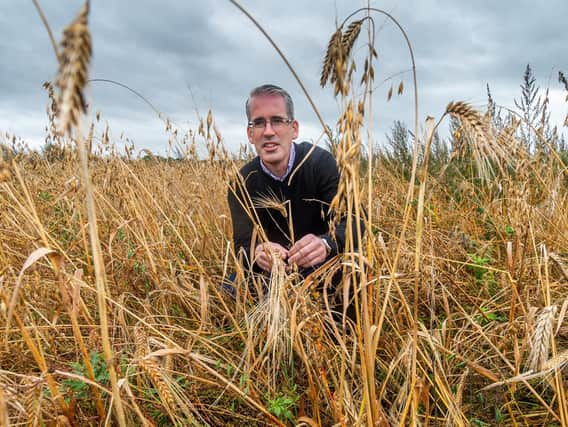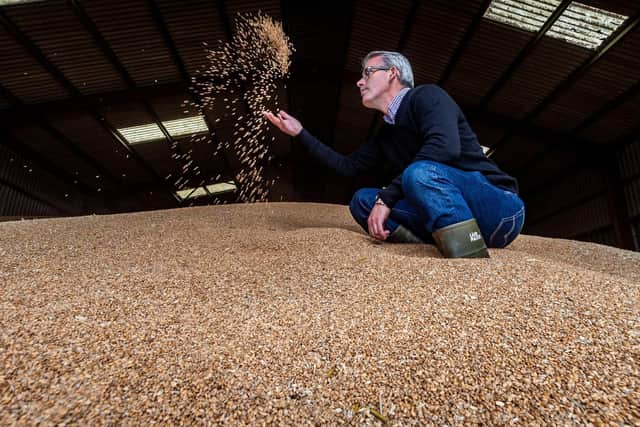How farmland birds are helping this award-winning farmer go from strength to strength


James O’Gram of Hayton Grange was surprised when he was nominated and thrilled when he was awarded the East Riding title two years ago having returned to Yorkshire in 2010 to take over the reins from his father Tim.
James said joining the Higher Level Stewardship scheme in December 2011 plays a major part in his farming enterprise across just over 1,000 acres in three locations at Hayton, Allerthorpe and Great Givendale.
Advertisement
Hide AdAdvertisement
Hide Ad“Our primary income from the farm is combinable cropping, growing winter wheat, oilseed rape, winter barley and spring barley across 520 acres. I came back home eleven years ago having worked in Suffolk as an agricultural consultant. I’m now the third generation to farm here.


“We decided that environmental stewardship was something to explore and have recently been accepted for a one-year extension to November 30, 2022. I’m hoping we will be offered a mirror agreement from December next year.
“We were fortunate to have a lot of farmland birds on our land already but through joining the HLS scheme we have successfully increased numbers and the number of species.
“We now have what is thought to be the largest number of corn buntings in East Yorkshire with regular flocks of over 50; and 100 lesser redpoll, redwing and linnet. There are also reed bunting, yellowhammer, yellow wagtail, tree sparrow, lapwing, grey partridge and skylark.”
Advertisement
Hide AdAdvertisement
Hide AdJames said much care and attention to detail has gone into providing the right environment to support the birds. “Corn bunting mix is grown across nearly 7.5 acres. It is made up of unharvested spring barley, spring triticale, oats and spring linseed drilled. The mix also provides winter food and cover.
“Uncropped, cultivated areas such as the corn bunting mix for ground nesting birds are important particularly for those that breed late and nest on ground that would often fail because of early harvests.
“We have 3.7 acres of wild bird cover; 2.5 acres of nectar flower mixture and 7.5 acres of fallow land all in one block next to the wild bird mixes. We also have skylark plots.”
The restoration of species-rich grassland, protection of archaelogical features such as the site of an old Roman fort and buffer strips also play their part. Hedgerows are managed, being cut on a cycle once every two years around the farm from mid-January through to February, leaving the fruit on until cutting.
Advertisement
Hide AdAdvertisement
Hide AdJames said the work at Grimthorpe Dale on the edge of the Yorkshire Wolds that now produces a colourful carpet of wildflower meadow is another of the achievements made.
“Sometimes I walk through this now wonderful dale area around five miles from Hayton Grange and think how marvellous it looks, but that perhaps there is only me benefiting although it has a countryside right of way along the edge of it, so I would hope others do too.
“We had identified it as an area of native grassland needing improvement. We spread green hay to introduce native meadow plants utilising local SSSI grassland from Bishop Wilton Poorland Trust. We had it cut from this donor site, baled the green hay, then transported it off site in a few hours.
“The bales went through a straw chopper and it was spread lightly on the surface at Grimthorpe where it was left for the cattle to trample. This was all completed over a two-year period.
Advertisement
Hide AdAdvertisement
Hide Ad"The wildflowers are now there in abundance and in April the dale is now alive with insects and wildlife.”
This year’s combinable cropping, which was completed in early September, saw the harvesting of 273 acres of winter wheat with varieties grown being Kerrin, Gleam, Gravity, Extase and Firefly.
James said yields weren’t looking too clever back in April.
“We ended up averaging around four tonnes per acre across a variety of land types from blow away ‘desert’ sand to heavy clay.
“Dad did a great job drying the grain that had come in at 17 per cent moisture. We are fortunate to have our own grain store as well as drying facilities.”
Advertisement
Hide AdAdvertisement
Hide AdThe oilseed rape crop was across 76 acres and James said that its poor yield had been saved by its current market price.
James said that he is far more nervous at this time of year in establishing crops for the following year than he ever is prior to harvest.
“We always get harvested but we don’t always get everything in the ground that we would like to. September 23 stays in my mind.
“We passed it this year in warm weather but that is the date in the past two when the weather has closed in and without the heroic efforts of our drilling contractors Martin and Ed Liversidge and Alistair Bramley we would have had hardly a crop to sell in 2020 or 2021.”
Advertisement
Hide AdAdvertisement
Hide AdJames said his involvement with an AHDB benchmarking group has led to an adoption of a new seed policy this year.
“Many of the members are dressing their own seed and I found that interesting in saving on seed costs. We started three years ago and have dressed a lot more this year with wheat varieties, Firefly, Extase and Gleam.”
Root crops, vining peas and an outdoor pig fattening enterprise for Anna’s Happy Trotters are also undertaken through various arrangements with others across 155 acres. The farm also runs to 115 acres of woodland.
James’ wife, Vicky, handles the farm accounts, having previously worked professionally in agricultural accounts practices. Vicky also runs a holiday let in Bishop Wilton and supports their daughters Emily and Lucinda’s competitive pony interests.